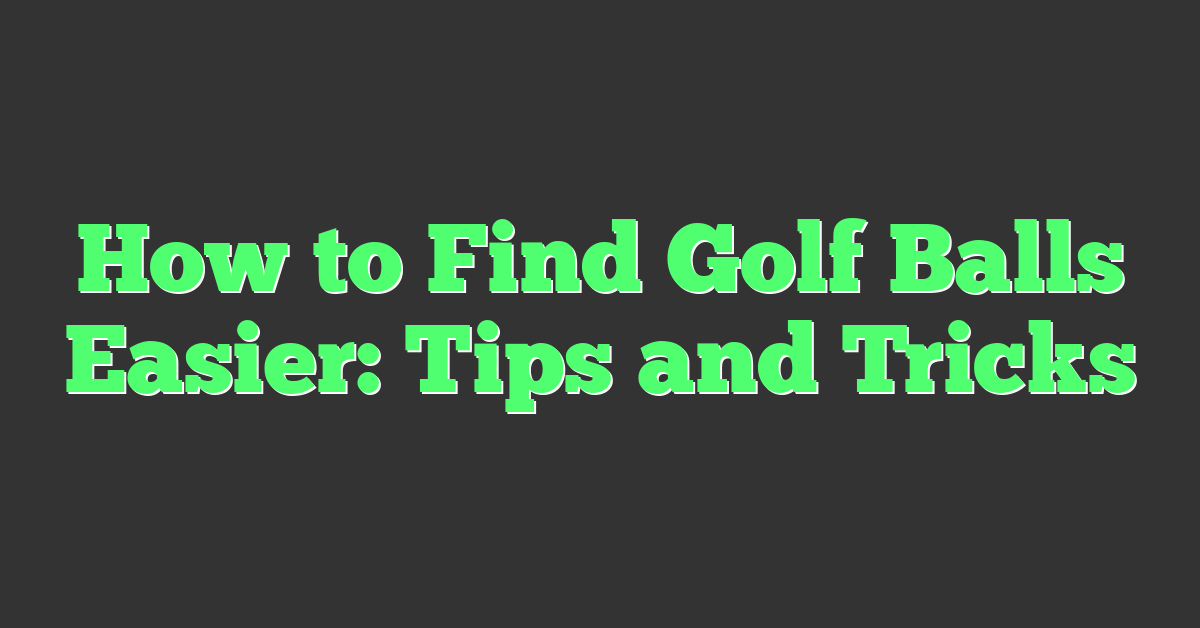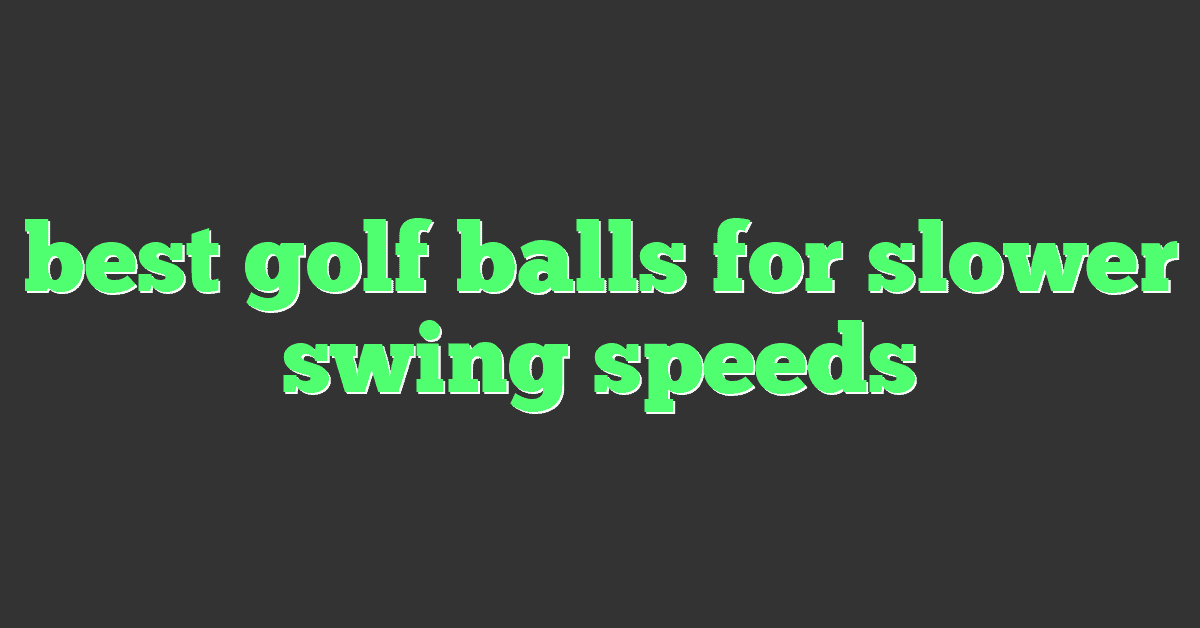If you’re an avid golfer, you know how frustrating it is to lose a golf ball. Not only does it slow down your game, but it can also be costly to replace lost balls. Fortunately, there are ways to improve your chances of finding your golf ball and minimizing your losses. In this article, we’ll provide you with tips and strategies to help you find golf balls easier.

One of the first things to consider when trying to find your golf ball is understanding the ball itself. Golf balls come in different types, each with its own unique features that can impact its visibility and how it behaves on the course. Knowing the type of ball you’re playing with can help you locate it more easily. Additionally, there are certain factors that can affect the visibility of your ball, such as color and design. We’ll cover these factors in more detail later on.
Another important aspect to consider is the equipment you use to find your golf ball. There are a variety of tools and gadgets available that can help you locate lost balls, such as ball retrievers and GPS trackers. In this article, we’ll discuss some of the most popular equipment options and how they can help you find your golf balls easier.
Key Takeaways
- Understanding the type of golf ball you’re playing with can help you locate it more easily.
- There are a variety of tools and gadgets available that can help you find lost golf balls.
- Factors such as color and design can impact the visibility of your golf ball.
Understanding Golf Balls
https://www.youtube.com/watch?v=4_8t0Nesqoc&embed=true
If you want to improve your golf game, understanding golf balls is essential. Golf balls are not just small, round objects that you hit with a club. They are designed to perform differently based on their type, design elements, and manufacturer.
Types of Golf Balls
There are three main types of golf balls: distance, control, and soft. Distance balls are designed to travel farther than other types of golf balls due to their low spin rate. Control balls are designed to provide more accuracy and control over your shots, but may not travel as far as distance balls. Soft golf balls are designed to provide a softer feel and more spin, which can help with accuracy and control.
Golf Ball Design Elements
Golf ball design elements can significantly impact the ball’s performance. Here are some design elements you should consider when choosing a golf ball:
Dimples: Dimples on a golf ball help reduce drag, which can increase the ball’s distance and speed. The number, size, and pattern of dimples can vary between golf ball models, so it’s essential to choose one that suits your playing style.
Compression: Compression refers to how much the ball compresses when hit. A low compression ball is softer and may travel farther, while a high compression ball is harder and may provide more control.
Cover Material: Most golf balls have a cover made of either urethane or surlyn. Urethane covers are softer and provide more spin, while surlyn covers are harder and provide more durability.
Number of Layers: Golf balls can have anywhere from one to five layers. The more layers a ball has, the more control and spin it may provide.
By understanding the different types and design elements of golf balls, you can choose the right ball for your game and improve your performance on the course.
Equipment to Find Golf Balls
https://www.youtube.com/watch?v=cUkTLp7M7eI&embed=true
If you’re tired of losing golf balls on the course, there are various pieces of equipment that can help you locate them more easily. Here are some of the best options:
Golf Ball Finders
Golf ball finders are small devices that use special filters to locate lost golf balls. They work by blocking out the colors of everything except for the white of the golf ball, making it easier to spot. Some golf ball finders come in the form of sunglasses, while others are handheld devices. They are relatively inexpensive and can save you a lot of money in the long run by helping you find your lost balls.
Ball Retrievers
Ball retrievers are long poles with a scoop or claw on the end that allow you to grab your golf ball from hard-to-reach places, such as water hazards or thick rough. They come in various lengths and sizes, so you can choose one that fits your needs. Ball retrievers are especially useful if you play on courses with a lot of water hazards.
Specialized Golf Gear
There are also a few other specialized pieces of golf gear that can help you find your lost balls. For example, some golf bags come with a built-in pocket specifically designed for holding lost balls. Additionally, there are golf ball finder apps available for your smartphone that use GPS technology to help you locate your lost balls.
Overall, investing in some golf ball finders, ball retrievers, or other specialized gear can make your golf game more enjoyable and save you money on lost balls.
High-Visibility Golf Balls
If you’re tired of losing golf balls on the course, you might want to consider using high-visibility golf balls. These golf balls come in a variety of colors, such as red, yellow, pink, orange, blue, and green, and they are designed to be easier to see than traditional white golf balls.
Benefits of High-Visibility Golf Balls
There are several benefits to using high-visibility golf balls. First and foremost, they make it easier to find your ball on the course. Whether you hit your ball into the rough, the sand trap, or the water, a brightly colored golf ball is much easier to spot than a white one.
In addition, high-visibility golf balls can help you keep track of your ball in flight. When you’re hitting shots into the sun, it can be difficult to see a white ball against the bright sky. A colored golf ball can help you keep your eye on the ball and make better contact.
Choosing the Right Color
When it comes to choosing a color for your high-visibility golf ball, it’s important to consider the conditions you’ll be playing in. If you’re playing on a course with a lot of trees and foliage, a bright green or yellow ball might be the best choice. If you’re playing on a course with a lot of water hazards, a bright orange or pink ball might be easier to spot.
It’s also important to consider your own personal preferences. Some golfers find that they prefer certain colors over others, and that those colors help them focus and play better golf.
Ultimately, the choice of color is up to you. Just remember that the goal of using a high-visibility golf ball is to make it easier to find your ball on the course, so choose a color that will stand out against the background.

« What Golf Ball Has the Most Spin: A Guide to Choosing the Right Ball for Your Game
Are Golf Balls Recyclable? Here’s What You Need to Know »
In conclusion, high-visibility golf balls can be a great tool for golfers looking to improve their game and reduce the number of lost balls. By choosing the right color and taking advantage of the benefits of these balls, you can improve your accuracy and have more fun on the course.
Improving Your Technique
https://www.youtube.com/watch?v=vBPHZaAnTQo&embed=true
If you’re struggling to find your golf balls on the course, improving your technique can help reduce the number of lost balls and lower your frustration levels. Here are some tips and techniques to help you find your golf balls easier and improve your game.
Tips for Reducing Lost Balls
One of the simplest ways to reduce lost balls is to keep your eye on the ball until it lands. This may sound obvious, but many golfers turn away in frustration before their ball has even landed. By keeping your eye on the ball, you can see where it lands and have a better chance of finding it.
Another tip is to use high-visibility golf balls. These balls are designed to be easier to spot on the course thanks to their bright colors, such as neon green, orange, or yellow. They can also help you find your ball faster and reduce the number of lost balls.

Additionally, try to avoid hitting your ball into areas with long grass or water hazards. These areas can make it difficult to find your ball, and you may end up losing it. Instead, aim for areas with shorter grass and fewer hazards.
Golf Lessons and Practice
If you’re serious about reducing lost balls and improving your golf game, consider taking golf lessons from a PGA pro. A pro can help you improve your swing, accuracy, and overall skills. They can also help you develop a strategy for finding your golf balls on the course.
Practice is also essential for improving your golf game and reducing lost balls. By practicing regularly, you can improve your skills and reduce your handicap. You can also learn how to hit your ball accurately and avoid hazards on the course.
In summary, improving your technique is essential for finding your golf balls easier and achieving a good score. By following these tips and taking lessons from a PGA pro, you can improve your abilities and reduce frustration on the course.
Strategies for Ball Searching
https://www.youtube.com/watch?v=srRLgt236FQ&embed=true

Searching for a lost golf ball can be frustrating, but there are a few strategies you can use to make it easier. Here are some tips to help you find your golf ball more efficiently:
Playing Partners’ Assistance
If you are playing with partners, ask them to help you search for your ball. Two pairs of eyes are better than one, and they may spot the ball in a location you missed. You can also split up and search different areas to cover more ground.
If you have a caddie, ask for their assistance as well. They may have experience in finding lost balls and can help you search more efficiently.
Systematic Search Patterns
When you are searching for your ball, it is important to have a systematic search pattern. Start by looking in the most likely places where the ball could have landed, such as the fairway or rough. If you still can’t find it, move to less likely areas, such as the woods or hazards.
Here are some systematic search patterns you can use:
- Grid search: Divide the area into sections and search each section systematically. This is a time-consuming method, but it is effective in finding lost balls.
- Clock search: Imagine the location where the ball landed as the center of a clock. Start at 12 o’clock and search in a clockwise direction, moving outward until you find the ball.
- Spiral search: Start at the location where the ball landed and search in a spiral pattern, moving outward until you find the ball.
Remember to mark the location where you found the ball so you can easily find it in the future. Using a GPS or rangefinder can also help you determine the exact location of your ball.
By using these strategies and enlisting the help of your playing partners or caddie, you can increase your chances of finding your lost golf ball and save yourself time and frustration on the course.
Golf Ball Visibility Factors
https://www.youtube.com/watch?v=98GN_aPvg2A&embed=true
When it comes to finding golf balls, there are several factors that can affect visibility. By understanding these factors, you can improve your chances of finding your ball and avoid unnecessary penalties.
Environmental Conditions
Environmental conditions such as lighting, weather, and terrain can all affect the visibility of your golf ball. In low-light conditions, it may be more difficult to see your ball, especially if it is a darker color. Wet conditions can also make it harder to spot your ball, as the water can create glare and reflections.

Golf Ball Contrast
The contrast between your golf ball and the surrounding environment can also affect visibility. For example, if you are playing on a course with a lot of greenery, a white or brightly colored ball may be more visible than a darker ball. On the other hand, if you are playing on a course with a lot of sand or dirt, a darker ball may be easier to spot.
To improve visibility, consider using a golf ball with a high-contrast design, such as a ball with a bold pattern or logo. You can also try using a ball with a matte finish, which can reduce glare and improve visibility in bright conditions.
Overall, by taking into account environmental conditions and golf ball contrast, you can improve your chances of finding your golf ball and avoid unnecessary penalties.
Cost Considerations
When it comes to finding the right golf ball for your game, cost is a major consideration. While some golfers may be willing to spend extra on high-end balls, others may prefer to stick to more affordable options. Here are some things to keep in mind when considering the cost of your golf balls.
Expensive vs Affordable Options
Golf balls can range in price from a few dollars to over $50 per dozen. Expensive balls may offer benefits such as higher spin rates, better feel, and longer distance, while more affordable options may be more forgiving and easier to control.

If you’re on a budget, don’t be afraid to opt for a more affordable ball. While you may not get all the bells and whistles of a high-end ball, you can still find options that offer decent distance and control at a lower price point.
On the other hand, if you’re willing to spend more, consider the benefits that come with a higher-priced ball. For example, some high-end balls may offer better spin rates, which can help you control your shots more effectively. Others may offer a softer feel, which can be more comfortable for some golfers.
Ultimately, the choice between expensive and affordable golf balls comes down to your personal preferences and budget. Consider what benefits are most important to you and choose a ball that fits your needs without breaking the bank.
Popular Golf Ball Brands
When it comes to finding the perfect golf ball, there are a lot of factors to consider, including spin, distance, and feel. One of the most important factors is the brand of the ball you choose to play with. Here are some of the most popular golf ball brands that you should consider.
Callaway
Callaway is one of the most popular golf ball brands in the world, and for good reason. Their balls are known for their excellent combination of distance and accuracy, making them a great choice for golfers of all skill levels. Callaway offers a wide range of golf balls, including the popular Chrome Soft and Chrome Soft X balls.

Titleist
Titleist is another popular golf ball brand that has been around for decades. Their Pro V1 and Pro V1x balls are some of the most popular balls on the market, and for good reason. They offer excellent distance, spin, and control, making them a great choice for golfers who want the best of the best.
Volvik Vivid
If you’re looking for a golf ball that stands out from the crowd, you might want to consider the Volvik Vivid. These brightly colored balls are hard to miss on the course, and they offer excellent performance as well. They are known for their soft feel and low compression, which makes them a great choice for golfers who want a ball that is easy to hit.
Overall, these brands are some of the most popular in the world of golf, and for good reason. They offer excellent performance and a wide range of options to choose from. When you’re looking for the perfect golf ball, be sure to consider these brands and their offerings.
Golf Ball Selection for Beginners
If you’re new to golf, choosing the right golf ball can be overwhelming. With so many options out there, it’s hard to know where to start. Here are some tips to help you select the right golf ball for your game.
Choosing the Right Golf Ball for Your Game
When it comes to selecting a golf ball, there are a few things to consider. First, think about your swing speed. If you’re a beginner, chances are your swing speed is on the slower side. In this case, you’ll want to look for a soft golf ball that will compress easily and help you get more distance.
Another thing to consider is the difficulty of the course you’ll be playing on. If you’re playing on a course with a lot of hazards, you’ll want to look for a golf ball that has good spin control and will help you avoid those hazards.
Professional players and tour pros tend to prefer golf balls that are designed for maximum distance and spin control. However, as a beginner, you don’t need to worry about these things just yet. Focus on finding a golf ball that will help you get the most out of your swing.
Lastly, don’t be afraid to experiment with different golf balls. Every golfer is different, and what works for one person might not work for another. Try a few different options and see which one feels best for you.
In summary, when selecting a golf ball as a beginner, consider your swing speed, the difficulty of the course, and don’t be afraid to experiment with different options. With these tips in mind, you’ll be well on your way to finding the right golf ball for your game.
Golf Ball Maintenance
Taking care of your golf balls is an important part of ensuring that they last longer and perform better. Here are some tips to help you maintain your golf balls.

Keeping Golf Balls Clean
Keeping your golf balls clean is crucial to their performance. Dirt and grime can affect the ball’s aerodynamics, making it harder to control. After each round, use a soft cloth or a ball cleaner to wipe off any dirt or grime. Avoid using water or solvents, as they can damage the ball’s cover.
Storage and Care
How you store your golf balls can also affect their performance. Keep them in a cool, dry place away from direct sunlight. Extreme temperatures can cause the ball to lose its balance and affect its performance. Avoid storing them in your car trunk or garage, as the heat can cause the ball to warp.
When carrying your golf balls, use a bag that has individual slots for each ball. This will help prevent them from rubbing against each other and getting scratched.
In addition to cleaning and storage, it’s important to inspect your golf balls regularly for any signs of damage. Check for cracks, cuts or other damage that could affect their performance. If you notice any damage, it’s best to replace the ball.
By following these simple tips, you can help your golf balls perform better and last longer.

Personal Preference and Experience
When it comes to finding the right golf ball, personal preference and experience play a crucial role. Every golfer is unique, and what works for one person may not work for another. Therefore, it is essential to find your ideal golf ball that suits your playing style and preferences.
Finding Your Ideal Golf Ball
To find your ideal golf ball, consider the following factors:
Skill Level: Your skill level is a crucial factor in determining the type of golf ball you need. If you are a beginner, you may want to choose a golf ball that provides more distance and forgiveness. On the other hand, if you are an experienced golfer, you may prefer a golf ball that offers more control and spin.
Swing Speed: Your swing speed also plays a significant role in selecting the right golf ball. If you have a slower swing speed, you may want to choose a golf ball that is softer and has a lower compression. This type of golf ball will help you generate more distance. If you have a faster swing speed, you may want to choose a golf ball that is firmer and has a higher compression. This type of golf ball will help you control your shots better.
Playing Conditions: The playing conditions also affect the type of golf ball you choose. If you are playing on a course with a lot of water hazards, you may want to choose a golf ball that has a softer cover. This type of golf ball will help you generate more spin and control your shots better. If you are playing on a course with a lot of wind, you may want to choose a golf ball that has a firmer cover. This type of golf ball will help you cut through the wind and maintain your distance.
Personal Preference: Ultimately, personal preference plays a significant role in selecting the right golf ball. Some golfers prefer a softer feel when striking the ball, while others prefer a firmer feel. Some golfers prioritize touch and control around the greens, while others prioritize distance and forgiveness. Therefore, it is essential to try out different golf balls and find the one that suits your playing style and preferences.
By taking into account your skill level, swing speed, playing conditions, and personal preference, you can find your ideal golf ball that will help you play your best. Don’t be afraid to try out different golf balls until you find the one that works for you. Remember, turning away from a golf ball that doesn’t work for you is not a sign of weakness, but rather a sign of a smart golfer who knows what they need.










